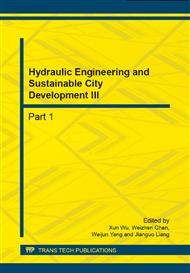[1]
G.J. Huffman, D.T. Bolvin, E.J. Nelkin, et al., The TRMM multisatellite precipitation analysis (TMPA): Quasi-global, multiyear, combined-sensor precipitation estimates at fine scales. J. Hydrometeorol. 8(2007) 38-55.
DOI: 10.1175/jhm560.1
Google Scholar
[2]
R. J. Joyce, J. E. Janowiak, P. A. Arkin, et al., CMORPH: A method that produces global precipitation estimates from passive microwave and infrared data at high spatial and temporal resolution. J. Hydrometeorol. 5(2004)487-503.
DOI: 10.1175/1525-7541(2004)005<0487:camtpg>2.0.co;2
Google Scholar
[3]
T. Ushio, K. Sasashige, T. Kubota, et al., A Kalman filter approach to the Global Satellite Mapping of Precipitation (GSMaP) from combined passive microwave and infrared radiometric data. J. Meteorol. Soc. Jpn. 87(2009)137-151.
DOI: 10.2151/jmsj.87a.137
Google Scholar
[4]
Y. Hong, D. Gochis, J. T. Cheng, et al., Evaluation of PERSIANN-CCS rainfall measurement using the NAME event rain gauge network. J. Hydrometeorol. 8(2007)469-482.
DOI: 10.1175/jhm574.1
Google Scholar
[5]
Y. Pan,Y. Shen, J.J. Yu, et al., Analysis of the combined gauge-satellite hourly precipitation over China basedon the OI technique. Acta. Meteorol. Sin. 70(2012)1381-1389.
Google Scholar
[6]
S. Sinclair, G. Pegram, Combining radar and rain gauge rainfall estimates using conditional merging. Atmos. Sci. Lett. 6(2005)19-22.
DOI: 10.1002/asl.85
Google Scholar
[7]
E. Todini, A Bayesian technique for conditioning radar precipitation estimates to rain-gauge measurements. Hydrol. Earth. Syst. Sc. 5(1999) 187-199.
DOI: 10.5194/hess-5-187-2001
Google Scholar
[8]
A. J. Pereira, Integrating gauge, radar and satellite rainfall. InProceedings of the 2nd International Precipitation Working Group Workshop, Monterey, CA, USA (2004).
Google Scholar
[9]
C. Berndt, E. Rabiei, U. Haberlandt, Geostatistical merging of rain gauge and radar data for high temporal resolutions and various station density scenarios. J. Hydrol. 508(2014)88-101.
DOI: 10.1016/j.jhydrol.2013.10.028
Google Scholar
[10]
A.Y. Xiong, P. Xie, J. Y. Liang, et al., Merging gauge observationsand satellite estimates of daily precipitation over China, inproc. 4th Workshop of the International Precipitation WorkingGroup (IPWG), Beijing, China, 2008, pp.13-17.
Google Scholar
[11]
D.A. Vila, L.G.G. de Goncalves, D.L. Toll, et al., Statistical evaluation of combined daily gauge observationsand rainfall satellite estimates over continental South America, J. Hydrometeor. 10 (2009)533-543.
DOI: 10.1175/2008jhm1048.1
Google Scholar
[12]
J. Rozante, D.S. Moreira, L.G.G. de Goncalves, etal., Combining TRMM and surface observations ofprecipitation: techniques and validation over South America, Weather. Forecast. 25(2010)885-894.
DOI: 10.1175/2010waf2222325.1
Google Scholar
[13]
M. Li, Q. Shao, An improved statistical approach to merge satellite rainfall estimates and rain gauge data. J. Hydrol. 385(2010)51-64.
DOI: 10.1016/j.jhydrol.2010.01.023
Google Scholar
[14]
L.J. Renzullo, A. Chappell, T. Raupach, et al., An assessment of statistically blended satellite-gauge precipitation data for daily rainfall analysis in Australia. In 34th International Symposium on Remote Sensing of Environment, Sydney (2011).
Google Scholar
[15]
A. S. Fotheringham, C. Brunsdon, M. Charlton. Geographically weighted regression: the analysis of spatially varying relationships. John Wiley &Sons (2003).
DOI: 10.1111/j.1538-4632.2003.tb01114.x
Google Scholar


